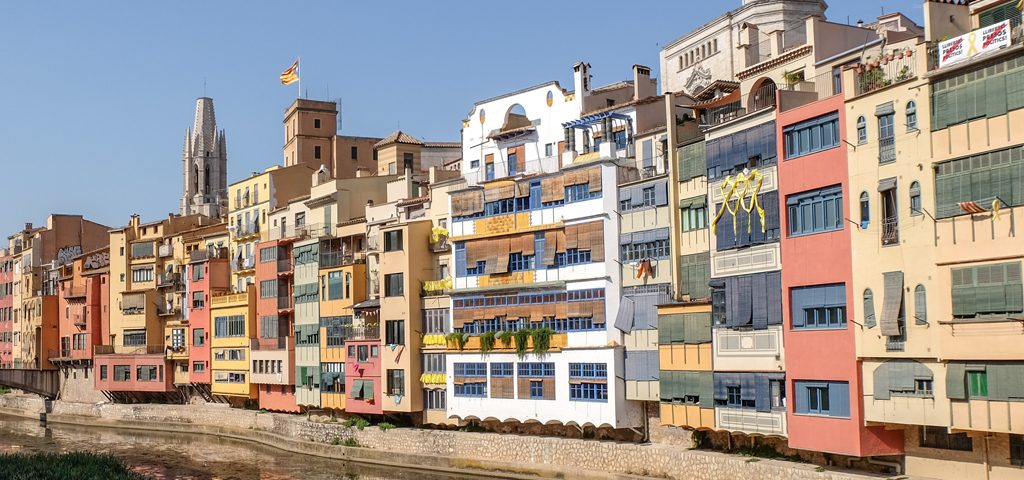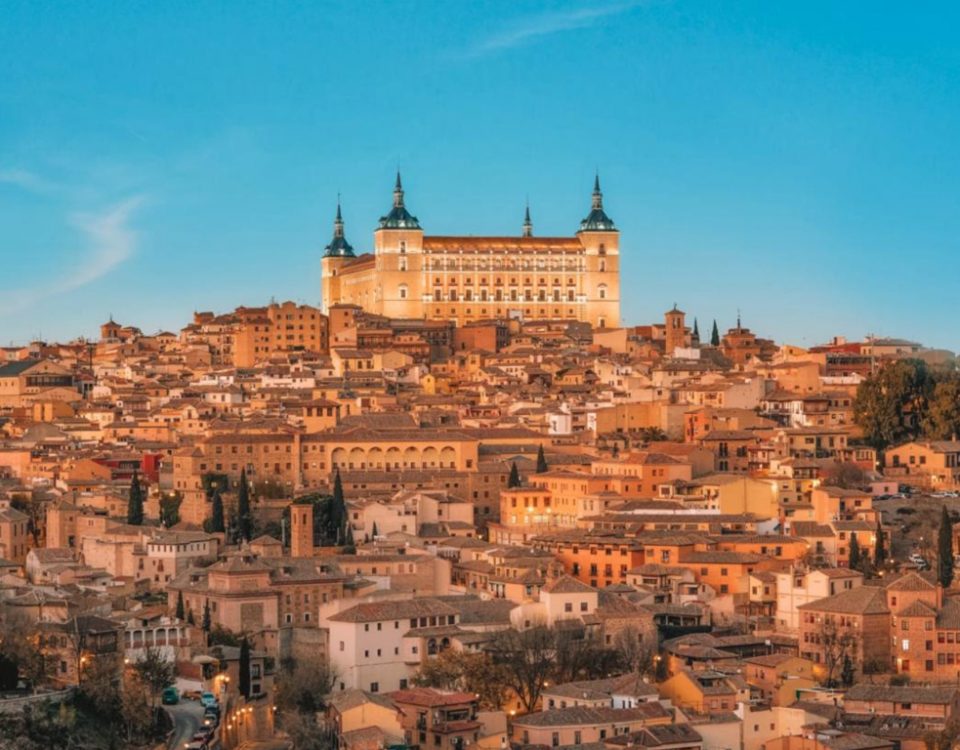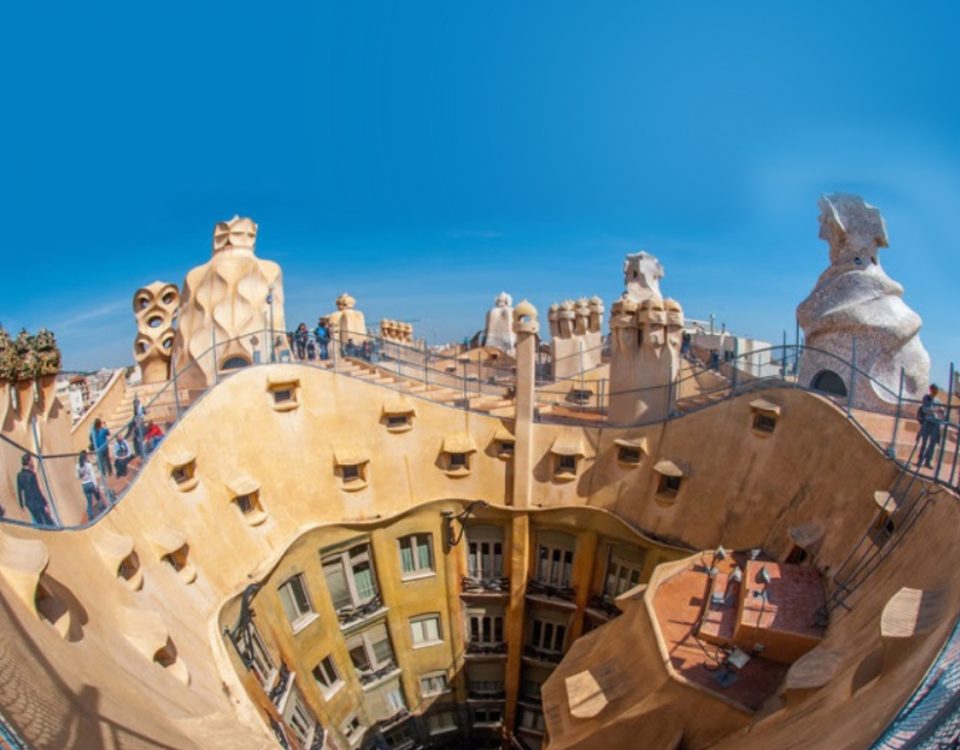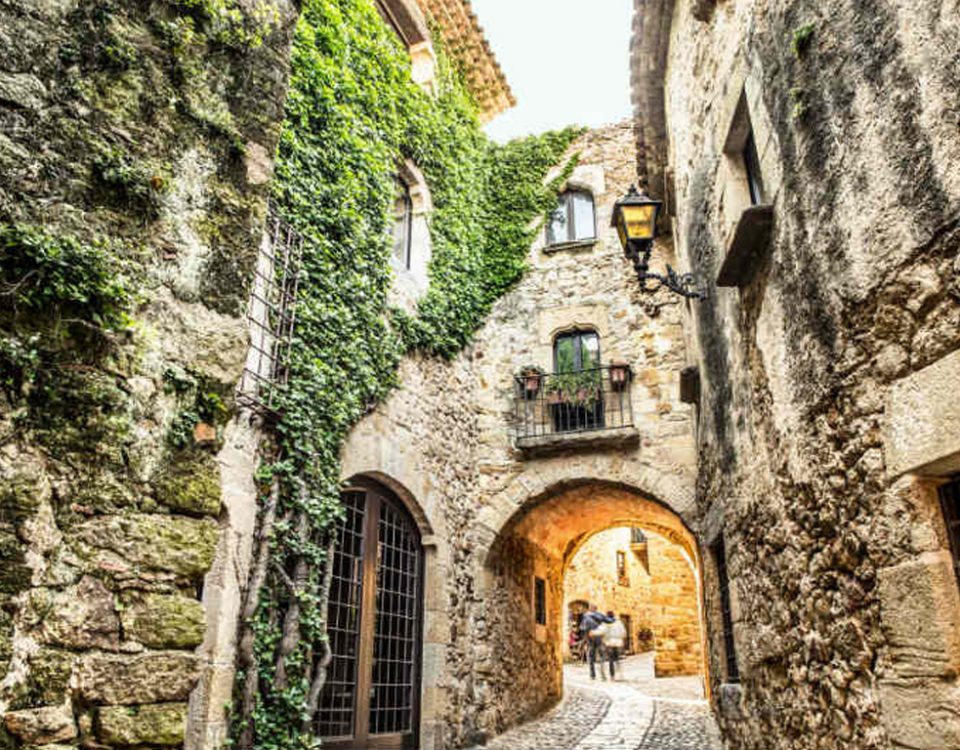
James Bond Views
June 30, 2020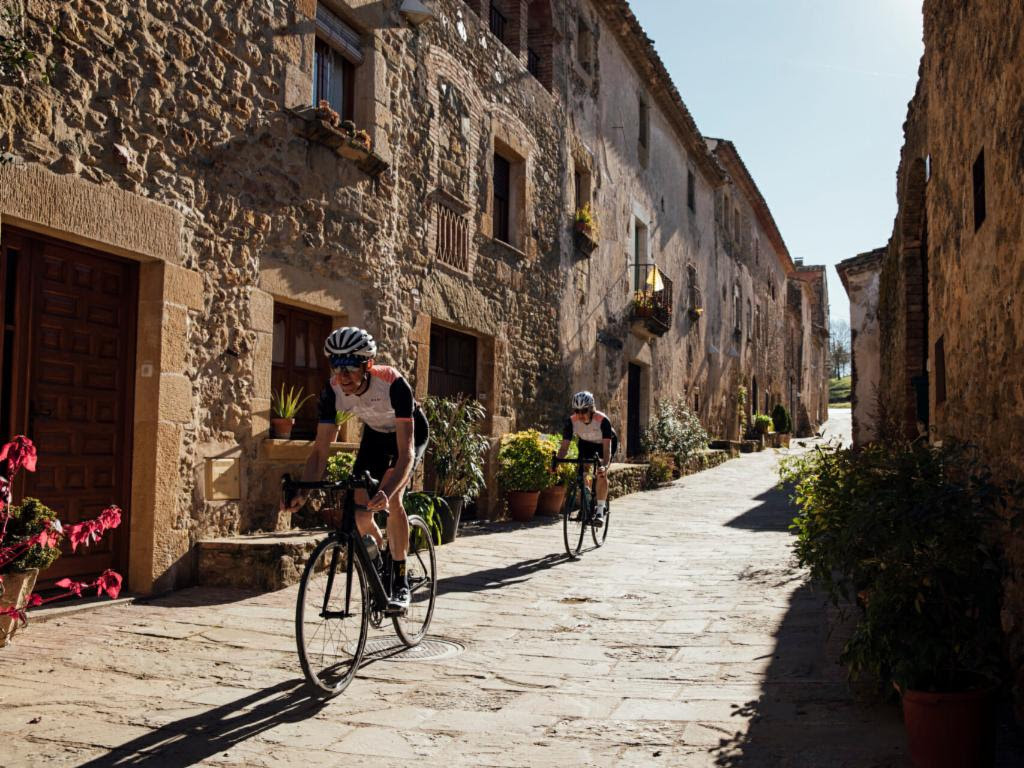
In Search of Lunch
July 24, 2020First forages for secrets of Girona are through gossamer veils of rain. Roadways and cobblestones are lacquered; vehicle tires and pedestrian footing unsure. Navigation into the city is circumvented around city center protesters, two thousand demonstrating at city hall on their lunch hour over the jailing of nine of their Catalan independence leaders. Crowds, draped in Catalan dragon coloured red and gold flags, are orderly, calm and disperse within an hour. Shaken, but not stirred, we slide on by foot to our brunch destination La Fabrica in Bari Vell (old town). This cycle-themed café is co-owned by Peloton and world championship cyclist Christian Meier and his Canadian wife Amber. Renowned for eco-conscious suppliers, communal tables and artisan brunch dishes, it’s a favourite among cyclists and Girona brunchers. The stone walled interior is set into a story below ground. We arrive to find it’s charming - and not open today. No problem, it’s an opportunity to explore more alleyways and discover more gastronomic possibilities. In a city with fifteen Michelin starred restaurants the challenge is choosing where to dine.
This mysterious medieval city perched on a conjunction of four rivers (Ter, Onyar, Güell and Galligants) is made up of a labyrinth of narrow streets and Bari Vell (the old town) to the east of the river Onyar and wide boulevards with modern commercialized neighbourhoods to the west. A jewellery box of robust ochre, yellow, terra cotta and salmon coloured houses sits on the waters of the Onyar river. Bari Vell, on the east reveals passages and staircases leading you to to Passeig de la Muralla, walkable ancient city walls offering an hour to two of spectacular panoramic views of the old city, the countryside and the Pyrennes in the distance. Ghosts and cosmopolitan locals lead you up and down mazes of medieval cobblestone alleys ranging from seven persons to two persons wide, under arches and through secret stone-walled alleyways to intimate garden size patios and more staircases. Bari Vell is atmospheric without a Games of Throne storyline. In the series Bari Vell plays the role of Free City of Essos, home to Arya Stark during her ‘girl with no name’ and temporary blindness phase in season six.
A hilly capital city of the province of Catalonia, Girona was founded by Iberians in 79 BC. Settled by Romans by citadel at the beginning of the 5th century, conquered by Visigoths then Moors who sacked it five times, and occupied intermittently by Franks (including King Charlemagne), Girona became the capital of the Catalonian Counties under Aragon and Barcelona in the late 9th century. While it suffered at least thirty sieges between the 3rd and the late 18th century it was truly only conquered five times. One siege was by the Franks in 1285. For months the Frank troops attacked from occupied Sant Feliu of Girona, the first Cathedral built, at the time located outside the city walls. Losing the siege, in frustration they desecrated the tomb of Saint Narcis laid to rest in the cathedral. From the tomb swarms of poisonous flies, the size of acorns, bluish green in colour emerged. The poisonous flies attacked the horses and soldiers; thousands died including the French king while returning to France. Thereafter every time Girona was under siege, the people of Girona carried the saint’s tomb with his recollected remains to the walls so he could defend the city with his powerful army of poisonous flies.
During the 11th to 13th centuries Girona’s wealth and reputation as a center of educational excellence contributed to the building of many fine Romanesque and Gothic buildings by some of Europe’s best architects. The School of Girona produced some of the most important writings of Jewish literature and Kabbalah mysticism. “El Call” the Jewish Quarter within Bari Vell next to the banks of the Onyar river is one of the most interesting and captivating areas in the city both in terms of architecture and history. Dating back to the 12th century it is one of the most well-preserved Jewish quarters in Europe. It flourished until 1492, the year in which the Jews were expelled from the country.
Landmarks are architectural wonders. We sway around curving stone alleyways for each reveal. Our first historical destination is of course the magnificent Cathedral of St. Mary of Girona constructed from the 11th to the 18th century. From a small alleyway we emerge onto its wide plaza on the west side. This side of the cathedral is Gothic, the outside stone soft and vulnerable. Interestingly, the odd ornamental dragon peers down at us from a rain spout. Swerving to the front entrance we find ourselves at the top of the now infamous ninety-nine steps Sir Jaime Lannister galloped up to confront the Faith of the Seven. Baroque in style, the front entrance portal is ornamented by the twelve apostles. Four bell towers (one built by King Charlemagne) break the skyline. There is little ornamentation, except oddly, a woman gargoyle attached to the wall in a downward-facing position. According to legend, once upon a time, a woman living in Girona, who was known to practice witchcraft, also had the habit of throwing stones at people taking part in religious processions and religious symbols, including the Cathedral. One day, after having thrown stones directly at the Cathedral, a voice called out to her and said, "Rocks you throw, rock you will remain!" At exactly that moment, the witch was turned into stone and attached to the building as the only human gargoyle drain spout so water, pouring from her mouth, would forever wash away her profanities.
Breathtaking, an engineering feat, we drink in the vast interior and varied materials (panelled wood, stone, marble, gold, ironwork, fine art). Stone cross vaults supporting Gothic buttresses 45 metres (148 feet) high create the widest Gothic vaulted nave constructed in the world (22.8 m or 72 feet). It’s the second widest nave after St. Peter’s Basilica. Magnificent stain glass windows pointing to the sky illuminate the chapels. While the cloisters are peaceful and lovely I am enamoured by the Tapestry of Creation, an 11th or early 12th century piece considered amongst the master works of Romanesque tapestry and The Gerona Beatus, a 10th century illuminated manuscript, both housed in The Cathedral Treasury and Museum.
A short espresso shot stop (or café con leche) at Café L’Arc, situated at the bottom of the cathedral steps and a sparrows fly from the Church of Sant Feliu energizes us for exploring the exquisitely preserved 12th century El Banys Arabs (Arab Baths). Impressed by the well preserved eight Romanesque columns we are fascinated by an irrigation system able to deliver hot or cold baths to separate spa enclaves.
Less walking distance than a modern city block are Sant Feliu of Girona (The Church of Saint Felix) and the Benedictine monastery of Sant Pere de Galligants. Beautifully situated, Sant Feliu of Girona’s construction occurred from the 12th century until the 17th century. Romanesque construction with a Gothic nave and covered baroque facade, it’s notable for its eight Roman and early Christian sarcophagi of the 3rd and 4th centuries, along with the Gothic tomb of Narcis of Girona, the tomb of the poisonous flies. Another secret legend involving Narcis belongs to the cult of the unearthly footprints. In 305 AD, Saint Narcis resided in Girona. Perceived as a threat to the Roman Empire, his execution was ordered. Hearing of his pursuers he fled a house (address 1 Pou Rodo) through the window. When landing it occurred to him to leave a footprint facing the opposite direction so it appeared he was entering the house. The pursuers saw the footprint and searched the house again and again convinced he had not left, giving him time to hide elsewhere far away.
Around the corner lower on the hill is the Benedictine monastery of Sant Pere de Galligants, one of the most important Catalan Romanesque landmarks. The monastery was built from 992, at the time outside the walls of Girona, when Ramon Borrell, count of Barcelona gave the monks rights over the quarter of Sant Pere. The monks held the ruler of the quarter until 1339, when King Peter IV of Aragon restored it to Aragon. Column motifs include vegetables, lions and sirens, including one with two tails.
There is a belief that the tradition of building over sacred places is to evoke telluric (magnetic fields) energies that intervene and partner with the new spiritual building. Rumoured to be under Sant Feliu is a crypt of a primitive Romanesque cathedral and catacombs next to subterranean passages which actually have been excavated and found to run under the old quarter and come out beyond the city walls. Carbonera, a well-known tunnel connects some of these major landmarks, other tunnels, private houses, convents and churches. Ironically Jews used the same passages to escape from the Jewish Quarter when attacked by Christians during their expulsion. The underground history of the city is still to be uncovered and understood.
Walking in the alley below the monastery we witness a modern secret. Under an arch just ten feet ahead of us, orange pylons are blocking cars from entering the cobblestone street. Eyes wide and mouths agape we watch a car drive over the pylons which descend into the road under the tires, returning to their sentinel stance once the tires pass. Sensors are clearly communicating between the car and the pylons, no doubt, built and installed by Q.
We’ve only scratched the surface of this city shimmering with 2,000 years of webbed secrets, myths and legends. There are artisan markets and museums, monasteries and monuments, chic shops and restaurants and lovely parks that appear like magic. Kissing El Cul de la Lleona, the lioness’s bottom, in the cathedral square is said to bring you luck or back to Girona. We’re delighted our haven is only a thirty-five minute drive away.
Want posts like this and more right to your inbox? Subscribe to Takes & Tales and receive Inquisitive Traveller stories, food, wine, music and reading suggestions. You’ll also learn about upcoming historical haven destinations. Subscribe today! You can unsubscribe anytime!

This mysterious medieval city perched on a conjunction of four rivers (Ter, Onyar, Güell and Galligants) is made up of a labyrinth of narrow streets and Bari Vell (the old town) to the east of the river Onyar and wide boulevards with modern commercialized neighbourhoods to the west. A jewellery box of robust ochre, yellow, terra cotta and salmon coloured houses sits on the waters of the Onyar river. Bari Vell, on the east reveals passages and staircases leading you to to Passeig de la Muralla, walkable ancient city walls offering an hour to two of spectacular panoramic views of the old city, the countryside and the Pyrennes in the distance. Ghosts and cosmopolitan locals lead you up and down mazes of medieval cobblestone alleys ranging from seven persons to two persons wide, under arches and through secret stone-walled alleyways to intimate garden size patios and more staircases. Bari Vell is atmospheric without a Games of Throne storyline. In the series Bari Vell plays the role of Free City of Essos, home to Arya Stark during her ‘girl with no name’ and temporary blindness phase in season six.
A hilly capital city of the province of Catalonia, Girona was founded by Iberians in 79 BC. Settled by Romans by citadel at the beginning of the 5th century, conquered by Visigoths then Moors who sacked it five times, and occupied intermittently by Franks (including King Charlemagne), Girona became the capital of the Catalonian Counties under Aragon and Barcelona in the late 9th century. While it suffered at least thirty sieges between the 3rd and the late 18th century it was truly only conquered five times. One siege was by the Franks in 1285. For months the Frank troops attacked from occupied Sant Feliu of Girona, the first Cathedral built, at the time located outside the city walls. Losing the siege, in frustration they desecrated the tomb of Saint Narcis laid to rest in the cathedral. From the tomb swarms of poisonous flies, the size of acorns, bluish green in colour emerged. The poisonous flies attacked the horses and soldiers; thousands died including the French king while returning to France. Thereafter every time Girona was under siege, the people of Girona carried the saint’s tomb with his recollected remains to the walls so he could defend the city with his powerful army of poisonous flies.
During the 11th to 13th centuries Girona’s wealth and reputation as a center of educational excellence contributed to the building of many fine Romanesque and Gothic buildings by some of Europe’s best architects. The School of Girona produced some of the most important writings of Jewish literature and Kabbalah mysticism. “El Call” the Jewish Quarter within Bari Vell next to the banks of the Onyar river is one of the most interesting and captivating areas in the city both in terms of architecture and history. Dating back to the 12th century it is one of the most well-preserved Jewish quarters in Europe. It flourished until 1492, the year in which the Jews were expelled from the country.
Landmarks are architectural wonders. We sway around curving stone alleyways for each reveal. Our first historical destination is of course the magnificent Cathedral of St. Mary of Girona constructed from the 11th to the 18th century. From a small alleyway we emerge onto its wide plaza on the west side. This side of the cathedral is Gothic, the outside stone soft and vulnerable. Interestingly, the odd ornamental dragon peers down at us from a rain spout. Swerving to the front entrance we find ourselves at the top of the now infamous ninety-nine steps Sir Jaime Lannister galloped up to confront the Faith of the Seven. Baroque in style, the front entrance portal is ornamented by the twelve apostles. Four bell towers (one built by King Charlemagne) break the skyline. There is little ornamentation, except oddly, a woman gargoyle attached to the wall in a downward-facing position. According to legend, once upon a time, a woman living in Girona, who was known to practice witchcraft, also had the habit of throwing stones at people taking part in religious processions and religious symbols, including the Cathedral. One day, after having thrown stones directly at the Cathedral, a voice called out to her and said, "Rocks you throw, rock you will remain!" At exactly that moment, the witch was turned into stone and attached to the building as the only human gargoyle drain spout so water, pouring from her mouth, would forever wash away her profanities.
Breathtaking, an engineering feat, we drink in the vast interior and varied materials (panelled wood, stone, marble, gold, ironwork, fine art). Stone cross vaults supporting Gothic buttresses 45 metres (148 feet) high create the widest Gothic vaulted nave constructed in the world (22.8 m or 72 feet). It’s the second widest nave after St. Peter’s Basilica. Magnificent stain glass windows pointing to the sky illuminate the chapels. While the cloisters are peaceful and lovely I am enamoured by the Tapestry of Creation, an 11th or early 12th century piece considered amongst the master works of Romanesque tapestry and The Gerona Beatus, a 10th century illuminated manuscript, both housed in The Cathedral Treasury and Museum.
A short espresso shot stop (or café con leche) at Café L’Arc, situated at the bottom of the cathedral steps and a sparrows fly from the Church of Sant Feliu energizes us for exploring the exquisitely preserved 12th century El Banys Arabs (Arab Baths). Impressed by the well preserved eight Romanesque columns we are fascinated by an irrigation system able to deliver hot or cold baths to separate spa enclaves.
Less walking distance than a modern city block are Sant Feliu of Girona (The Church of Saint Felix) and the Benedictine monastery of Sant Pere de Galligants. Beautifully situated, Sant Feliu of Girona’s construction occurred from the 12th century until the 17th century. Romanesque construction with a Gothic nave and covered baroque facade, it’s notable for its eight Roman and early Christian sarcophagi of the 3rd and 4th centuries, along with the Gothic tomb of Narcis of Girona, the tomb of the poisonous flies. Another secret legend involving Narcis belongs to the cult of the unearthly footprints. In 305 AD, Saint Narcis resided in Girona. Perceived as a threat to the Roman Empire, his execution was ordered. Hearing of his pursuers he fled a house (address 1 Pou Rodo) through the window. When landing it occurred to him to leave a footprint facing the opposite direction so it appeared he was entering the house. The pursuers saw the footprint and searched the house again and again convinced he had not left, giving him time to hide elsewhere far away.
Around the corner lower on the hill is the Benedictine monastery of Sant Pere de Galligants, one of the most important Catalan Romanesque landmarks. The monastery was built from 992, at the time outside the walls of Girona, when Ramon Borrell, count of Barcelona gave the monks rights over the quarter of Sant Pere. The monks held the ruler of the quarter until 1339, when King Peter IV of Aragon restored it to Aragon. Column motifs include vegetables, lions and sirens, including one with two tails.
There is a belief that the tradition of building over sacred places is to evoke telluric (magnetic fields) energies that intervene and partner with the new spiritual building. Rumoured to be under Sant Feliu is a crypt of a primitive Romanesque cathedral and catacombs next to subterranean passages which actually have been excavated and found to run under the old quarter and come out beyond the city walls. Carbonera, a well-known tunnel connects some of these major landmarks, other tunnels, private houses, convents and churches. Ironically Jews used the same passages to escape from the Jewish Quarter when attacked by Christians during their expulsion. The underground history of the city is still to be uncovered and understood.
Walking in the alley below the monastery we witness a modern secret. Under an arch just ten feet ahead of us, orange pylons are blocking cars from entering the cobblestone street. Eyes wide and mouths agape we watch a car drive over the pylons which descend into the road under the tires, returning to their sentinel stance once the tires pass. Sensors are clearly communicating between the car and the pylons, no doubt, built and installed by Q.
We’ve only scratched the surface of this city shimmering with 2,000 years of webbed secrets, myths and legends. There are artisan markets and museums, monasteries and monuments, chic shops and restaurants and lovely parks that appear like magic. Kissing El Cul de la Lleona, the lioness’s bottom, in the cathedral square is said to bring you luck or back to Girona. We’re delighted our haven is only a thirty-five minute drive away.
Want posts like this and more right to your inbox? Subscribe to Takes & Tales and receive Inquisitive Traveller stories, food, wine, music and reading suggestions. You’ll also learn about upcoming historical haven destinations. Subscribe today! You can unsubscribe anytime!


